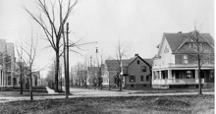Echota
Echota was a town in Niagara Falls built in the 1890s, with beautiful homes designed for workers of the Niagara Falls Power Company.
In the 1890s, efforts increased to harness the raging waters of Niagara Falls and generate and distribute hydroelectric power beyond the area to places like Buffalo. For that, a massive powerhouse complex needed to be built and skilled laborers were in high demand. To attract workers to the city, the Niagara Falls Power Company secured 84-acres of vacant land in which to build worker homes. Workers would live near the company, walk to work, and rent affordable homes in a utopian community named Echota.
Edward Dean Adams, president of the Cataract Construction Company, chose the name Echota after the ancient Cherokee capitol in Georgia. Even “though the original meaning of the word had become lost, Adams romantically interpreted it to mean ‘town of refuge.’” Echota was located near Hyde Park Boulevard and Buffalo Avenue.
World-renowned architect Stanford White designed the neighborhood. Instead of names, the streets were assigned letters A-F. Maple and elm trees were planted. Between 1892 and 1895, 67 houses, or 112 total units, were built as singles, duplexes, and row houses in Queen Anne and Georgian architectural styles. Beneath the triangular gables of the natural wood shingle homes were luxuries like running water, indoor plumbing, and electric lights. Electricity, even for many wealthy families, was still years away for most homes.
In addition to some of the most beautiful and envied homes in Niagara Falls, Echota had a community center, a school, stores, a firehouse, a public bath, and a railroad station. Overall, Echota “was meant to be a model not only of industrial progress but also of social and even aesthetic progress.”
In 1895, electricity transmitted from Niagara Falls reached a nearby factory and, a year later, it turned on Buffalo street lamps. For the 1901 Pan American Exposition, a World’s Fair held in Buffalo, all the houses in Echota were painted yellow and it was the first neighborhood to be illuminated “like a picture postcard.” Afterwards, the Expo’s color schemes were so popular that homes in Echota “were painted in vibrant, eye-catching colors and soon became an attraction for travelers visiting the Falls.”
Echota began to gradually decline in 1910 after the company sold it.
In recent years, Habitat for Humanity has built new homes in the area and others have worked to restore old homes. In many ways, the working-class community of Echota is a story of water and light, innovation, intense labor, and the people living there who helped make history happen.
Hope L. Russell, Ph.D.


